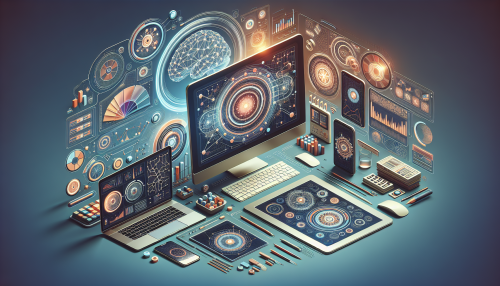How AI Is Quietly Changing Your Everyday Tech
Brian Taylor October 24, 2025
Explore how artificial intelligence is reshaping daily experiences, from personalized recommendations to enhanced device security. This in-depth guide unpacks the real ways AI influences your life and what emerging trends to look out for if you’re curious about the future of smart technology.
AI’s Invisible Hand in Everyday Devices
Artificial intelligence no longer feels like something from science fiction. In fact, AI powers many of the digital services people use daily. Smart assistants respond to voice commands and organize calendars. Streaming platforms recommend new shows or music based on patterns in your behavior. Even photo apps now use computer vision to automatically sort and tag images. It all feels seamless. Many users may not notice these algorithms working in the background, but their presence is fundamental to the digital world. The integration of artificial intelligence into routine gadgets shows how quickly technology adapts to individual preferences and habits, making life a bit smoother without fanfare.
Phones and home devices are loaded with AI-driven features. Digital cameras rely on algorithms to adjust lighting, stabilize shaky videos, and even help create sharp focus. Wearables monitor sleep and fitness details by analyzing large volumes of data in real time. Automated translation in messaging or email is becoming stronger, thanks to deep learning models trained on diverse samples. The cumulative effect is convenience. Tasks that once needed manual input or technical know-how become simple button presses or spoken words. When voice recognition improves or cameras get smarter, it’s AI breaking new ground in usability.
Even older technology finds new life when AI is added. Think about spam filters in email—the more spam you report, the better the system learns. Navigation apps, once reliant only on static maps, now consider traffic patterns, user reports, and historical data to suggest the quickest route. Quiet advances like these reflect a sophisticated yet practical use of AI in consumer technology. Improvements happen with small updates or feature rollouts, but overall, they raise the bar for how well devices serve each individual user. It’s the invisible hand of AI guiding the technology relied on every day.
Personalization and Recommendation Engines
Personalized experiences define much of modern digital life. Think about how your video streaming queue, news feed, or shopping suggestions seem uncannily tailored. AI recommendation engines learn from your clicks, watch time, and even pauses on particular content. This kind of processing turns data into actionable insights, fine-tuning recommendations with every interaction. It feels helpful—like someone who knows your taste curating options just for you. These systems combine massive data sets with powerful algorithms to improve over time, quietly shaping online discovery and entertainment in subtle yet significant ways.
Understanding the background mechanisms can be enlightening. Collaborative filtering is a common approach, where AI looks at similarities in behavior across thousands or millions of users to find trends. When one person enjoys certain movies or products, the system identifies others with similar patterns and makes suggestions accordingly. Some platforms go further, using content-based filtering to match new content against your established preferences. The outcome is more intuitive than guessing or searching on your own. It’s a deep integration where almost every scroll or tap is processed to refine the experience further.
The advantages of this approach stretch beyond entertainment. Online education platforms use AI to suggest courses after analyzing what learners complete or struggle with. Retailers adjust promotions for individuals, presenting deals likely to catch your interest. Even digital health apps prompt behaviors based on historical patterns—such as exercise reminders or nutritional tips. As recommendation engines grow smarter, their predictions often become nearly invisible, woven into interfaces so smoothly that users may not realize decisions are being nudged and shaped behind the scenes.
AI and Data Privacy: What’s at Stake?
With artificial intelligence handling such vast troves of personal data, privacy concerns have naturally increased. AI systems need huge datasets to learn and improve. This constant need for information may cause some to wonder: Is personal data safe from misuse? Security experts and regulators focus on safe data handling, pushing for rules around transparency, consent, and security practices. Encryption, anonymization techniques, and robust access controls have become critical. These layers safeguard sensitive information from unauthorized exposure, building trust even as AI systems become more pervasive in everyday tech.
Regulatory bodies in regions like the EU and California have reacted with frameworks such as the General Data Protection Regulation (GDPR) and the California Consumer Privacy Act (CCPA) (https://gdpr.eu/). These regulations enforce user rights around transparency, data access, and opting out of automated profiling. Leading technology companies have started making privacy features part of their selling points. Some offer granular control over what gets collected. Others pledge to process data on the device, not in the cloud, to limit exposure. For users, understanding evolving privacy policies and tools gives more say over which data gets processed and how it’s used.
Balancing convenience with confidentiality remains a challenge. AI makes services more responsive but sometimes at the cost of greater data sharing. Research in privacy-preserving machine learning explores ways for AI systems to learn from encrypted or decentralized data—so personal details don’t have to leave your device. This area continues to expand, as demand grows for services that offer both powerful AI features and strong privacy protections. Staying informed—reading updates, using privacy controls, and choosing transparent providers—remains the most effective strategy for anyone concerned about the intersection of AI and personal information.
AI Is Transforming Security Features
Security is one of the most promising frontiers for AI in consumer tech. Machine learning helps flag suspicious network activity or potential breaches much faster than manual review. Biometric authentication, where devices use fingerprints, facial recognition, or voice patterns, relies on sophisticated AI models. These approaches allow smartphones, laptops, and home assistants to recognize authorized users seamlessly. With so many connected devices, strong security isn’t just a bonus—it’s a requirement for peace of mind. As we carry even more sensitive information in our pockets, the methods for safeguarding it must also adapt and evolve.
AI-driven security isn’t just about keeping hackers out. It extends to personal safety through advanced algorithms that detect fraud, alert users to phishing attempts, or monitor unusual patterns in account activity. Many email platforms and banking apps have adopted machine learning–based fraud detection, which identifies out-of-the-ordinary transactions in real-time, blocking threats before they escalate. Even parental controls and content moderation on social apps increasingly depend on AI to spot and filter risky or malicious behavior. This tech not only saves time but also reduces the potential for human error by automating complex, repetitive security tasks.
As deepfakes and other AI-generated attacks become more common, the need for countermeasures has grown. Researchers are developing tools that analyze digital content for signs of manipulation—like unnatural blinking rates or irregular audio cues. Anti-malware and antivirus programs use algorithms that learn from new threats as they appear, adapting quickly in a world where cyber risks constantly change. For anyone navigating the digital landscape, these shifts mark a new chapter in how users can feel protected, with AI acting as both a shield and a watchdog over their digital lives.
Smart Homes, Smarter Living: AI’s Impact
Households are increasingly adopting smart technologies—another area where AI is redefining daily experiences. Smart thermostats learn routines and automatically adjust the environment for efficiency and comfort. Intelligent lighting systems respond to movement, voice commands, or programmed schedules, tuning brightness and color based on user needs. Appliances such as refrigerators, ovens, or washing machines now connect to home networks, using artificial intelligence to optimize energy use or suggest maintenance.
Security cameras and doorbells use AI for real-time object recognition, distinguishing between family members and strangers. Robotic vacuum cleaners map out rooms and adapt patterns based on obstacles or even pet activity. All these advances aim to free up time by automating tedious or repetitive chores, helping people focus on more meaningful activities. By analyzing daily habits, AI-powered devices anticipate needs, creating a proactive, rather than merely reactive, home environment.
Integration with voice assistants brings control to a new level. Saying “turn off the lights” or “play morning playlist” feels natural, and each command feeds data back into AI systems to further personalize the experience. Over time, smart homes promise improved accessibility and convenience, supporting aging in place or accommodating unique needs. The potential continues to grow as more devices become connected and smarter algorithms are deployed, making daily life easier, healthier, and more responsive inside the home.
Emerging Trends in AI for Consumer Tech
What’s next for artificial intelligence in consumer technology? Edge computing is a fast-moving trend, bringing more AI processing onto your device rather than relying on distant cloud servers. This improves both privacy and speed. Smaller, more efficient models train on-device, powering everything from voice command recognition to real-time video analysis. Wearables, medical sensors, and augmented reality glasses increasingly run AI tasks locally, boosting responsiveness even as connectivity fluctuates or lags.
Natural language understanding keeps evolving. Digital assistants can handle more complex sentences and even context changes in conversation. Language generation models make interacting with devices feel more human. Image and video recognition are reaching new levels—think about live translations, visual search in e-commerce, or augmented reality overlays for education. These upgrades open doors for accessibility, language learning, and collaboration on a global scale, democratizing technology for broader audiences.
Transparency and explainability have become new watchwords. Developers and researchers urge methods so that AI-powered decisions can be trusted—and, if needed, challenged or understood by everyday users. As society grows more reliant on artificial intelligence, responsible design, clearly communicated features, and careful monitoring are more crucial than ever. Navigating the future of smart technology depends on harnessing innovation while staying aware of risks—and always putting people first.
References
1. European Commission. (n.d.). Artificial Intelligence. Retrieved from https://digital-strategy.ec.europa.eu/en/policies/artificial-intelligence
2. Pew Research Center. (2023). AI and Human Enhancement: Americans’ Openness Is Tempered by a Range of Concerns. Retrieved from https://www.pewresearch.org/internet/2023/03/31/ai-and-human-enhancement-americans-openness-is-tempered-by-a-range-of-concerns/
3. Future of Privacy Forum. (2023). Privacy and Artificial Intelligence: A Regulatory Perspective. Retrieved from https://fpf.org/blog/privacy-and-artificial-intelligence-a-regulatory-perspective/
4. Stanford University. (n.d.). Artificial Intelligence Index Report. Retrieved from https://aiindex.stanford.edu/report/
5. General Data Protection Regulation. (n.d.). Complete guide to GDPR compliance. Retrieved from https://gdpr.eu/
6. U.S. Cybersecurity & Infrastructure Security Agency. (2023). Artificial Intelligence Security. Retrieved from https://www.cisa.gov/resources-tools/resources/artificial-intelligence-security





